|
|
Caribbean National Forest/
Luquillo Experimental Forest
A Managed Forest in the Tropics
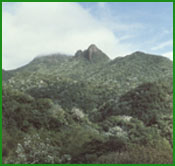
If the clouds lift, even momentarily, El Yunque rock is visible to the northeast. At 3,469 feet (1,058 m) in elevation, El Yunque is the second highest peak in the Caribbean National Forest and its most visible point in the horizon. The Taino Indians considered this a sacred place and the seat of their god Yuquiyú. With the clouds almost constantly drifting over the mountain and the stillness and beauty of this place, it is easy to see why they felt this way.
On a clear day, from Mt. Britton Tower you can see the city of Luquillo straight ahead. Far to the northwest you will glimpse the tip of Isla Verde, in the outskirts of San Juan, the capital of Puerto Rico -- just a speck on the horizon. But mostly you will see the forest. A warm climate and as much as 240 inches (610 cm) of rain a year have produced a dense evergreen forest, rich in native flora and fauna -- 225 native tree species, a vast variety of vines, ferns, giant tree ferns and mosses, and more than 100 species of vertebrates. Thirty five species are endemic -- meaning they can be found nowhere else. Of these, five are considered threatened or endangered, including the beautiful and rare Puerto Rican Parrot.
Forest Types
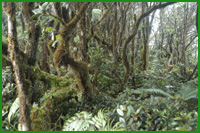
From Mt. Britton four of Puerto Rico's distinct forest types can be seen: Tabonuco, Palo Colorado, Sierra Palm, and Cloud Forest. Tabonuco forest is dominated by the majestic Tabonuco Tree (Dacroydes excelsa) that can reach up to 100 feet (30 m) and grows primarily in protected sites at low elevations. Tabonuco forest has many of the characteristics for which tropical rain forests are noted. The forest canopy has three levels: an upper level that may be as much as 35% Tabonuco, a lower canopy, and an under story. The second most prominent tree in this forest type, the Motillo (Sloanea berteriana), has large buttress roots, typical of many rain forest trees. Such roots help support the heavy canopy of large trees growing in very wet soil. The forest floor is only scarcely vegetated, but the forest canopy is rich with aerial plants: bromeliads, orchids, vines, and arboreal ferns.
Above 2,000 feet (600m) is the Palo Colorado forest. It takes its name from the Palo Colorado (Cyrilla racemiflora), a tree that is also found in Central and South America and the southeastern United States. Tree height in the Palo Colorado forest is less than 50 feet (15m), and the layers of the forest canopy are less distinct than in the Tabonuco type.
At about the same elevation as the Palo Colorado, but on very steep slopes, are the Sierra Palm forests dominated by the Sierra Palm (Prestoea montana). Sometimes called palm-breaker, this forest type may reach 50 feet (15m) in height.
At the highest elevations, near the top of EL Yunque, grows the cloud forest, also known as dwarf or elfin forest or moss forest. This forest type is composed of very dense stands of small, stunted trees and shrubs. The cloud forest has many of the same tree species as the Palo Colorado, but growth is limited by adverse climate -- heavy rain, strong winds, and almost constant cloud cover.
Forest Decline
From Mt. Britton, the forest seems to stretch forever. However, this is only an illusion. Very little is left of the magnificent forests that once covered the island of Puerto Rico. Since first they were seen by Christopher Columbus on his second voyage to the New World in 1493, Puerto Rican forests have been subjected to intensive use and abuse. With increasing population, the forests were cleared to make way for human settlements, farms, coffee plantations, and other agricultural crops. By early 1900s, probably 85 percent of the original forests were gone.
The lowland Ausubo (Manilkara bidentata) forests were the first to be cut. Very little of that forest type remains. The Tabonuco forest was once an important habitat of the Puerto Rican Parrot, and destruction of much of this forest type is a likely cause of the species' decline. The Parrot, a beautiful green bird with bright-blue wing feathers, is now rarely seen. It survives only in small numbers in an isolated area of the Caribbean National Forest and in a captive population used for breeding purposes.
More of the Palo Colorado type remains, but in the 1940s and 1950s, many large, old Palo Colorado trees were selectively cut for charcoal or to encourage growth of trees more valuable for timber. This destruction occurred before scientists learned that the Parrot nests in these trees.
Forest of Many Names
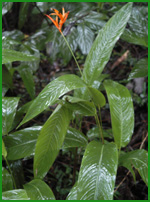
The Caribbean National Forest contains land that was part of the original forest reserves set aside by the Spanish in 1876. Originally just 12,400 acres (5,020 ha), this reserve now covers more than 28,000 acres (11,300 ha). It includes the largest block of undisturbed forest on the island. Unique in the tropics, the Caribbean National Forest is the oldest forest reserve in the National Forest System and has been under some form of management for more than 100 years.
The reserve is managed by the U. S. Department of Agriculture Forest Service and has two primary functions -- management and research -- from which the area takes its two names: Luquillo Experimental Forest and Caribbean National Forest. Actually, the forest has had many names over the years, names that reflect a long and colorful history. First called Yuké by the Tainos, and later El Yunque by the Spaniards, in 1903, President Roosevelt proclaimed it the Luquillo Forest Reserve. In 1935 this was changed to Caribbean National Forest and in 1956, the forest was also designated Luquillo Experimental Forest in recognition of the growing importance of research in the reserve. Often, however, the forest is locally referred to as El Yunque, its second oldest and most picturesque name.
The Caribbean National Forest is part of the National Forest System and is managed by law for multiple use benefits. Areas within the forest are dedicated to what is considered their best uses whether for outdoor recreation, watershed protection, wildlife habitat, or growing trees.
Outdoor Recreation
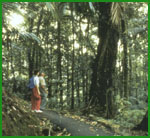
In the forest, there are many opportunities for outdoor recreation. The coolness of the mountains draws people from the urban centers of San Juan and other towns in the warm and humid coastal lowlands. Puerto Rico is the cruise ship hub for the Caribbean and also has the largest and busiest airport in the region. Tourism represents 12 percent of the local economy and El Yunque is the first nature destination in the Island. Of the more than 700,000 visitors to the forest in 2004, 38 percent were international and 42 percent were local.
For these visitors, the first contact with the Forest Service if often with interpretive displays and a fine film at the splendid El Portal Rain Forest Center, located at the entrance to the Forest. Its unique, award winning tropical architecture, inserted in a spectacular natural setting is combined with the attention of the USDA Forest Service staff who are available to assist and answer questions about El Portal and El Yunque's educational and recreational opportunities. Whether backpacking, bird watching, hiking, picnicking, playing in the water, attending a special event or taking a guided tour, your experience will be unforgetful.
Watershed Protection
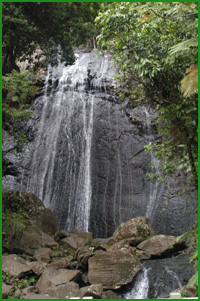
Water is the unifying element and the determining factor for the characteristics of the forest. Over 200 inches of rain, or about 100 billion gallons, fall every year over the expanse of El Yunque. Eight major rivers have their headwaters in the Caribbean National Forest and provide water and hydroelectric power for towns and rural areas in eastern Puerto Rico. Today critical watersheds, peaks, ridges, and steep slopes are off limits to timber harvesting. As a result, filtered by vegetation, these are some of the purest waters found on the island. Visiting recreation sites around water bodies and cooling off in the ponds, rivers, and waterfalls is a favorite activity for both local and foreign visitors alike.
Wildlife Habitat

The entire forest is also a wildlife refuge. It has 68 species of native birds, many migratory birds, and numerous reptiles and amphibians. At night, the rain forest resounds with a loud chorus that may include 16 different species of miniature tree frogs -- the beloved coquís of Puerto Rico. The only native mammals are bats. However, mongooses, rats, and domestic cats have been introduced and now run wild.
Baño de Oro Natural Area
Three fourths of all the virgin (primary) forests that remain in Puerto Rico are located in the experimental forest. To protect this unique and valuable resource, some 2,100 acres (850 ha) have been set aside as the Baño de Oro Natural Area. Timber harvest is not allowed in this area, and no roads or trails maybe built.
Important Trees
Although timber is considered to be an important use of the forest, very little has been cut in recent years. In fact, the Forest Reserve was created in response to deforestation, and emphasis has been on reforesting cutover areas. Over the years, many acres have been planted with trees. In the future these plantations will be an important and sustainable source of timber for local use.
The Caribbean National Forest has 225 different species of trees and a highly diverse plant community typical of tropical rain forests around the world. Some of the most important or interesting native trees are listed here:
- Ausubo (Manikara bidentata) is a large, slow-growing tree with a dense crown of dark-green elliptical leaves. The wood of ausubo is beautiful, resistant to termites and rot, and highly desirable for furniture and construction purposes. This was once one of the most important timber tree in Puerto Rico. Now, few large, old trees remain.
- Fern trees (Cyathea urbureu and C. aquilina) are among the most beautiful and fascinating plants of tropical forests. These small, evergreen trees have slender trunks and feathery, lacy leaves called fronds. The Carib Indians used the hollow stems to carry and preserve fire. Now these stems are cut for use as planters for orchids and bromeliads or for potting material. Fern trees are also used in home and commercial gardens. Unfortunately, most of the fern trees are stolen from along forest roads.
- Palo Colorado (Cyrilla racemiflora) is a very large tree that may live to be 1,000 years old. Its name comes from its reddish bark, which splits off in thin plates or scales. Large, old Palo Colorado trees are important nest trees for the Puerto Rican Parrot. Many of these trees support complete communities of other plants: vines, mosses, herbs, ferns, liverworts, and even seedlings of other tree species.
- Tabonuco (Dacroydes excelsa)
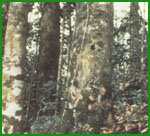 is perhaps the stateliest tree in El Yunque. These forest giants often reach a height of 100 feet (30 m) and a diameter of 40 inches (1 m). The smooth, pale bark often exudes a white resin useful for starting fires and for incense. The wood of the Tabonuco was used by Tainos to construct canoes, and later to make furniture and boxes, but today it is rarely cut. is perhaps the stateliest tree in El Yunque. These forest giants often reach a height of 100 feet (30 m) and a diameter of 40 inches (1 m). The smooth, pale bark often exudes a white resin useful for starting fires and for incense. The wood of the Tabonuco was used by Tainos to construct canoes, and later to make furniture and boxes, but today it is rarely cut.
- Sierra Palm (Prestoea montana) is a striking feature of the Luquillo Mountains. Although palms are
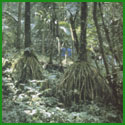 slow growing, they reproduce in abundance in the shade of the forest floor and survive hurricanes that topple many broad-leaved trees. Palm fruits are produced all year and are a staple food of the Puerto Rican Parrot.
slow growing, they reproduce in abundance in the shade of the forest floor and survive hurricanes that topple many broad-leaved trees. Palm fruits are produced all year and are a staple food of the Puerto Rican Parrot.
International Institute of Tropical Forestry
Establishment of a forestry research station in Puerto Rico was authorized by Congress in 1927, but it was not until 1939 that the Tropical Forest Experiment Station, now called the International Institute of Tropical Forestry, was created. Located on the grounds of the Agricultural Experiment Station at the University of Puerto Rico in Río Piedras, the Institute has become a focal point for forestry research and education in tropical America.
Together, the International Institute of Tropical Forestry and the Caribbean National Forest have pioneered the application of sound forest management principles in Tropical America. Between 1931 and 1956, the amount of land in the Caribbean National Forest was increased and consolidated from surrounding farmlands, and trespass was essentially eliminated. By 1975, 10,000 acres (4,000 ha) of land had been replanted. Today, plantation forests look so much like native forests that few people can tell them apart, and they have many of the same benefits. In 1934, as an aid to reforestation efforts, research was initiated on natural regeneration and species trials begun. Growth records have been kept on approximately 20,000 trees for more than 50 years.
Researchers at the Institute were the first to report decrease in the Puerto Rican Parrot population in the National Forest. Subsequently, a monitoring and research program was begun, and the parrot was given protection under the Endangered Species Act. Over the years, the captive flock has continued to increase, giving hope that the wild population can eventually be reestablished.
In 1989, the experimental forest was designated for a long-term ecological research by the National Science Foundation. As a result, scientists are now learning more about the native flora and fauna and how to react to natural and human caused disturbances.
Over the years, the International Institute of Tropical Forestry has enjoyed a growing reputation in forestry extension and education. Thousands of people have participated in training courses and technical meetings, and the library has one of the best collections of tropical forestry information in the world.
Highlights in the History of the Caribbean National Forest/Luquillo Experimental Forest
1839 - First Spanish forest comprehensive law for Puerto Rico.
1876 - The Spanish Crown proclaims El Yunque and other areas in Puerto Rico as forest reserves.
1903 - President Roosevelt designates the Luquillo Forest Reserve (now called Caribbean National Forest).
1905 - The Bureau of Forestry, U. S. Department of Agriculture, publishes the first detailed report about the forest and its resources.
1931 - The first forest plantations (mahogany) are established.
1933 - The Emergency Conservation Program began. With the Civilian Conservation Corps (1937) extensive work is accomplished in reforestation and road and recreational facilities construction.
1935 - Name changed to Caribbean National Forest.
1937 - First timber inventory completed.
1939 - Tropical Forest Experimental Station (now International Institute of Tropical Forestry) established.
1946 - Forest designated as a wildlife refuge.
1956 - Entire forest designated as the Luquillo Experimental Forest in recognition of the growing importance of research.
1968 - Conservation efforts began for the Puerto Rican Parrot.
1976 - The Caribbean National Forest is designated as a Biosphere Reserve.
1988 - Experiment Station receives a grant from the National Science Foundation for long-term ecological research.
1988 - El Portal Visitor Center planning is initiated.
1989 - Hurricane Hugo causes major damage to the forest, Catalina Work Center, and to the recreational areas. Wild Parrot population reduced to half.
1992 - International Institute of Tropical Forestry is established, enhancing international cooperation and collaboration.
1996 - El Portal Tropical Forest Center opens, continuing a tradition of education, outreach, and public service.
2003 - The Centennial of the proclamation of the Luquillo Forest Reserve is celebrated with a year of special events.
2005 - The Centennial of the creation of the USDA Forest Service is celebrated.
For more information, go to http://www.fs.usda.gov/elyunque/.
Please note: This summary and excerpts were adapted from Luquillo Experimental Forest by John K. Francis and J. Louise Matrantonio, General Technical Report IITF-14, August 2001.
|









 is perhaps the stateliest tree in El Yunque. These forest giants often reach a height of 100 feet (30 m) and a diameter of 40 inches (1 m). The smooth, pale bark often exudes a white resin useful for starting fires and for incense. The wood of the Tabonuco was used by Tainos to construct canoes, and later to make furniture and boxes, but today it is rarely cut.
is perhaps the stateliest tree in El Yunque. These forest giants often reach a height of 100 feet (30 m) and a diameter of 40 inches (1 m). The smooth, pale bark often exudes a white resin useful for starting fires and for incense. The wood of the Tabonuco was used by Tainos to construct canoes, and later to make furniture and boxes, but today it is rarely cut. slow growing, they reproduce in abundance in the shade of the forest floor and survive hurricanes that topple many broad-leaved trees. Palm fruits are produced all year and are a staple food of the Puerto Rican Parrot.
slow growing, they reproduce in abundance in the shade of the forest floor and survive hurricanes that topple many broad-leaved trees. Palm fruits are produced all year and are a staple food of the Puerto Rican Parrot.